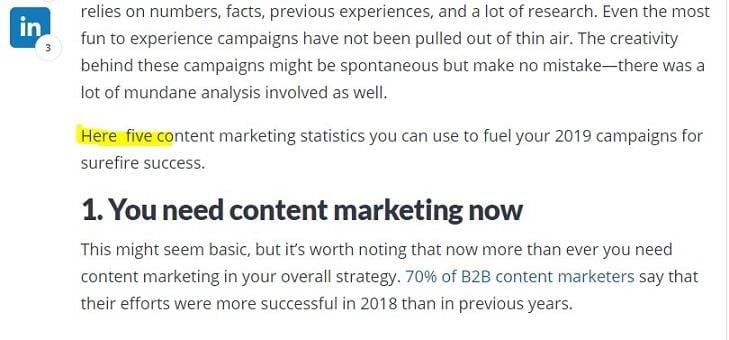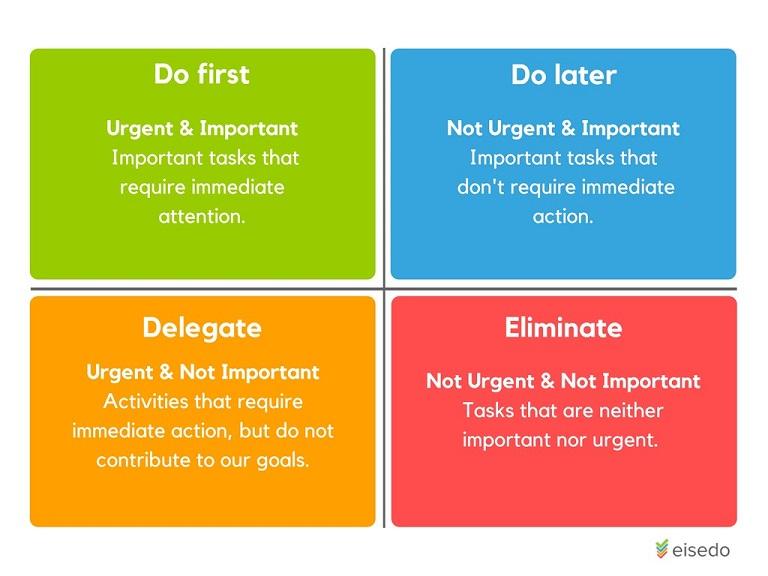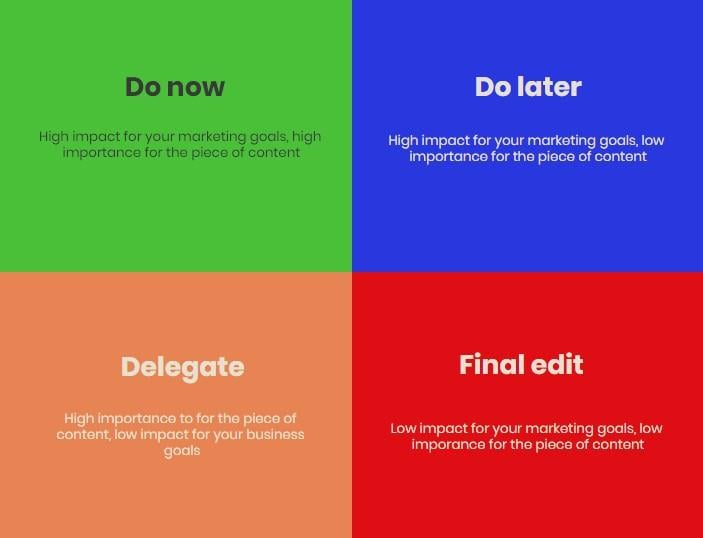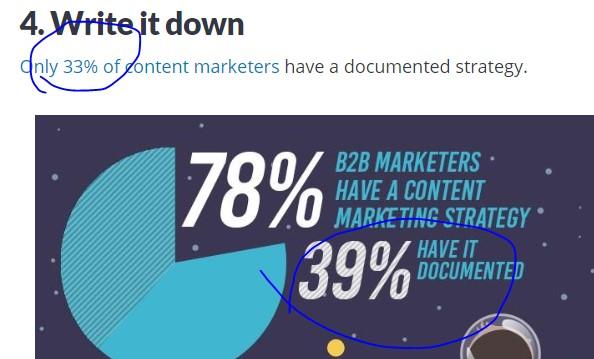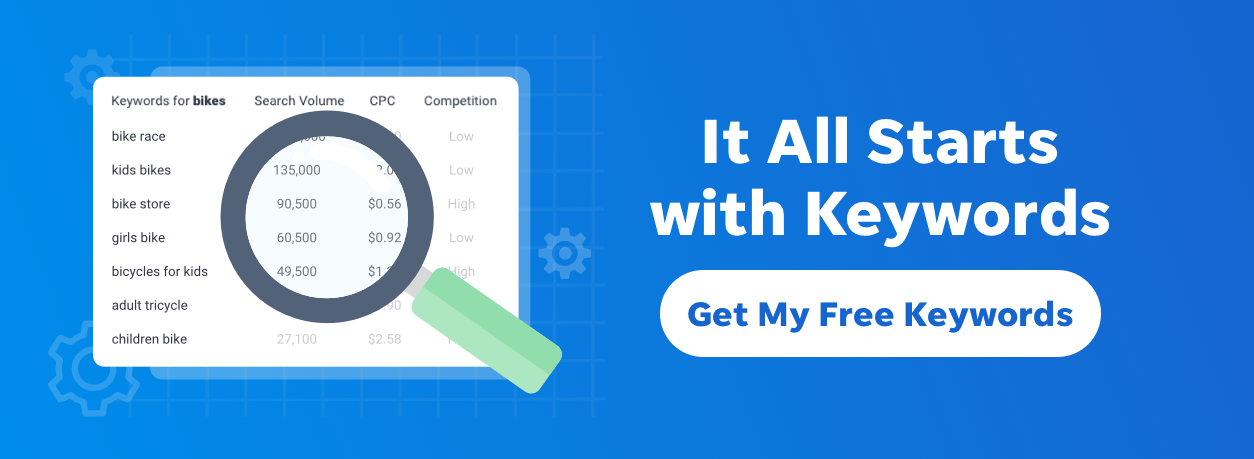
The Last Guide to Content Editing You’ll Ever Need
I have to confess: Even though I’m correcting punctuation and reviewing sentence structure at work all day, I don’t care when I see a typo in a book. Sure, I might circle it so I remember, but I don’t feel vindicated. If anything, I feel bad. When it’s in a blog post I’ve edited, I’m bummed I made a mistake.
But I’d rather content I’ve edited have a missing period or an extra capital letter than have logical flaws or offer questionable value any day. The missing period and extra capital letters are mistakes, sure, but they’re easy fixes. Rethinking the structure of a guide or making a supporting example stronger? Those are much harder improvements to make and, frankly, they’re much more important for the reader.
Okay, admittedly, you could argue this typo could be bad for the reader.
In order to make sure your whitepapers, blog posts, ebooks, and more are ready to share with your readers, you need to make sure these higher-order content concerns are addressed first. In other words, you need a round of content editing.
In this guide, I’ll cover everything you need to know to get the most out of content editing, including:
- What content editing is
- Why it’s important for marketers
- How to prioritize your content editing
Let’s get started.
What is content editing?
Content editing is a stage and style of editing with the goal of reviewing writing to check how effective, cohesive, and understandable it is.
But what does that mean in practice? If you’re content editing, you’ll pay attention to how the writing fits with your brand voice. You’ll read a whitepaper looking for logical holes or missing pieces, you’ll make sure the tips in an email are useful and applicable, and you’ll want to make sure the scope of a blog post fits a reader’s needs and works for your business.
You’ll also pay attention to how well the content delivers on the promise of the headline and subheads. If this “What is content editing?” section, for example, didn’t include a definition, you’d notice that during content editing and delegate back to the writer—but more on figuring out when to jump in and when to delegate shortly.
Content editing vs. copy editing
So what’s the difference between content editing and copy editing? Here’s a simple break down. Content editing ensures that writing is effective, cohesive, and understandable. This means checking the strength and logic of the argument, the quality of the sources or examples, the match with your brand voice, and the scope of the piece.
Copy editing, on the other hand, identifies and corrects more surface-level mistakes. This means checking spelling, grammar, punctuation, syntax, and style guide agreement. It could also mean double-checking graphs, charts, and image placement, and proofreading the title, meta descriptions, and captions.
Why is content editing important for marketers?
In content marketing, this type of editing is often grouped into the final copy editing or proofreading stage. It’s clear why this happens: We’re busy, and when you have a list of blog posts to edit for next week, a folder of emails to review, and still want to eat lunch, grouping these two editing tasks together seems like the best way to finalize all that content and still manage to leave your desk.
But that doesn’t mean it always works.
Sad example of my own rushed editing.
Establishing and maintaining copy editing standards for your content improves the quality and authority of your content and your brand—-but your audience won’t care about clean, legible copy that doesn’t make sense and your boss won’t care about content that doesn’t align with your overall marketing objectives. Marketers need content editing to make sure they’re generating high-quality content that provides value to readers and contributes to business goals.
Now, let’s get into how to do that.
How do you figure out what to prioritize for content editing?
This, friends, is the challenge. You don’t want to waste time re-working a section of a guide to the Google Merchant Center that would better as its own blog post. You don’t want to spend hours retrofitting a guest post to a keyword that doesn’t relate to your business.
And you still really, really don’t want to publish a blog post riddled with silly, embarrassing typos.
During content editing you need to consider two things:
- Does the content meet quality standards?
- Does the content accomplish its purpose?
For content marketing, the overarching purpose of the content, at least, is almost always defined well before its creation—especially if your company has a content marketing mission statement. Your content should contribute to your marketing goals.
Quality standards will depend more on the form of the content—email, blog posts, guides—and your brand standards. But all high-quality content will be readable, actionable, and shareable.
Once you have the focus of your content editing clear, you can use a quick tool to prioritize.
You might be familiar with the Eisenhower Decision Matrix, the productivity tool that might be the best thing to remember from Stephen Covey’s 7 Habits of Highly Effective People.
The use for this is simple: Consider the tasks at hand and group them into the four quadrants in this matrix. Your Q3 goals due, well, yesterday? Urgent and important, do those now. Weekly 1:1 with your boss? Not urgent but important, schedule a time to do that. Link building for recent blog posts? Delegate. Helping out with planning for the marketing team holiday video? Not important and not urgent yet—say no for now and eliminate it.
See how quickly the matrix can help prioritize a list of tasks? That’s ideal for productivity in general. It’s also ideal for content editing.
Here’s a content editing version of this matrix to help you determine where to focus your time and attention just as quickly:
This will help guide the same rapid-fire prioritizing to make your content editing not only easier to tackle, but also more effective. Now, let’s take a closer look at each of these categories will mean in practice.
Do now: High importance, high impact
This is the worst quadrant, but that’s okay—ideally, these edits will come up least often. These are issues that impact both the quality of the content and its ability to contribute to your marketing goals.
If an infographic has a misattributed customer quote, for example, this needs to be fixed before anything else happens. You don’t want to impact the customer relationship or publish inaccurate information. That’s a do now.
These issues should be rare, but when they do come up, these are first priority.
Delegate: High importance, low impact
Let’s consider a few examples here. A content marketer wrote a blog post about ad copy without including an image of an ad anywhere in the piece. A copywriter sent over some video scripts that’s relying on tongue-twisting jardon. A product marketer drafted a one-sheeter for a product launch that uses internal and external messaging—there’s no clear audience.
In these instances, the quality of the content is impacted by these misses; this content hasn’t even made it to impacting your business goals yet. Make note of what’s missing or not working in the copy and explain what revisions need to happen to improve the piece. Then, send it back to the writer for revising.
Do later: Low importance, high impact
With these edits, the content is strong and clear, and with that high-quality content, there’s opportunity to edit for high-impact business value. Include links to other relevant content. Find a keyword—even low-volume keywords can help your SEO. While you’re at it, revise headings for better SEO. Resize images. Include a CTA for your upcoming event.
At this stage, you have high-quality content already, so you’re looking to make it do more for your business goals.
Final edit: Low importance, low impact
Spending time catching comma splices only to go back and cut those extra sentences later. Changing the capitalization of subheadings only to realize halfway through they’re not parallel and need to be rewritten. Adding up all the figures in a table only to figure out it needs to be represented as a graph. Correcting punctuation errors throughout an introduction that doesn’t set accurate expectations for the reader. The immediate gratification of productivity is tempting, but wasting that time—and, worse, doing it all over again—is frustrating. So don’t do that yet.
Just be sure to go back and fix it before publishing a mistake like this.
Skip over correcting grammar or checking figures for now, and then go back in with your content style guide handy.
Build content editing into your process
If you want to ensure that your content is working for you, you need to make a point to add content editing to your content creation process. If you’re in charge of editing, add it as a step in your process documentation and block off time on your calendar for to get used to the step. If you don’t have a clear editing step—or an editor at all—for your content, talk to your coworkers about establishing a peer editing step. And, remember, this content editing decision matrix is just like any other tool—it doesn’t do you any good unless it’s easily accessible and clear. So bookmark this post or print out this matrix and (most importantly) use it!
Meet The Author
Céillie Clark-Keane
Céillie is Head of Marketing for Building Ventures, a VC firm focused on funding and mentoring early-stage startups in the built environment space. Previously, Ceillie led content strategy for Unstack and managed the award-winning blog at WordStream.
See other posts by Céillie Clark-Keane
More Articles Like This
Comments
Please read our Comment Policy before commenting.

